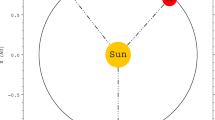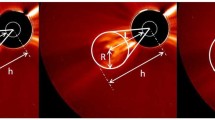Abstract
We study the initiation and development of the limb coronal mass ejection (CME) of 15 May 2001, utilizing observations from Mauna Loa Solar Observatory (MLSO), the Solar and Heliospheric Observatory (SOHO), and Yohkoh. The pre-eruption images in various spectral channels show a quiescent prominence imbedded in the coronal void, being overlaid by the coronal arch. After the onset of rapid acceleration, this three-element structure preserved its integrity and appeared in the MLSO MK-IV coronagraph field of view as the three-part CME structure (the frontal rim, the cavity, and the prominence) and continued its motion through the field of view of the SOHO/LASCO coronagraphs up to 30 solar radii. Such observational coverage allows us to measure the relative kinematics of the three-part structure from the very beginning up to the late phases of the eruption. The leading edge and the prominence accelerated simultaneously: the rapid acceleration of the frontal rim and the prominence started at approximately the same time, the prominence perhaps being slightly delayed (4 – 6 min). The leading edge achieved the maximum acceleration amax≈ 600 ± 150 m s−2 at a heliocentric distance 2.4 –2.5 solar radii, whereas the prominence reached amax≈ 380± 50 m s−2, almost simultaneously with the leading edge. Such a distinct synchronization of different parts of the CME provides clear evidence that the entire magnetic arcade, including the prominence, erupts as an entity, showing a kind of self-similar expansion. The CME attained a maximum velocity of vmax≈ 1200 km s−1 at approximately the same time as the peak of the associated soft X-ray flare. Beyond about 10 solar radii, the leading edge of the CME started to decelerate at a≈−20 m s−2, most likely due to the aerodynamic drag. The deceleration of the prominence was delayed for 10 –30 min, which is attributed to its larger inertia.
Similar content being viewed by others
References
Anzer, U. and Pneuman, G. W.: 1982, Solar Phys. 79, 129.
Brueckner, G. E., Howard, R. A., Koomen, M. J. et al.: 1995, Solar Phys. 162, 357.
Cargill, P. J., Chen J., Spicer, D. S., and Zalesak, S. T.: 1996, J. Geophys. Res. 101, 4855.
Chen, J.: 1989, Astrophys. J. 338, 453.
Chen, J., Krall J.: 2003, J. Geophys. Res. 108, A11, 1410, DOI 10.1029/2003JA009849.
Delaboudiniere, J.-P., Artzner, G. E., Brunaud, J. et al.: 1995, Solar Phys. 162, 291.
Dere, K. P., Brueckner, G. E., Howard, R. A., Michels, D. J., and Delaboudiniere J. P.: 1999, Astrophys. J. 516, 465.
Donelly, B. R. and Unzicker, A.: 1974, NOAA Tech. Memo ELR SEL-72.
Engvold, O.: 1988, in E. R. Priest (ed), Dynamics and Structures of Quiescent Solar Prominences, Kluwer, p.47.
Feynman, J. and Ruzmaikin, A.: 2004, Solar Phys. 219, 301.
Fisher, R. and Poland, A. I.: 1981, Astrophys. J., 246, 1004.
Fisher, R., Garcia, C. J., and Seagraves, P.: 1981, Astrophys. J. 246, L161.
Forbes, T. G.: 1990, J. Geophys. Res. 95, 11919.
Forbes, T. G.: 2000, J. Geophys. Res. 105, 23153.
Gopalswamy, N., Lara, A., Yashiro, S., Kaiser, M.L., and Howard R. A.: 2001, J. Geophys. Res. 106, 29207.
Hudson, H. S., Acton, L. W., Harvey, K. L., and McKenzie, D. E.: 1999, Astrophys. J., 513, L83.
Hundhausen, A. J.: 1987, in V., Pizzo, T., Holzer, and D. G., Sime (eds), Proc. Sixth International Solar Wind Conference, Boulder: NCAR, p.181.
Illing, R. M. E. and Hundhausen, A. J.: 1985, J. Geophys. Res. 90, 275.
Isenberg, P. A., Forbes, T. G., and Démoulin, P.: 1993, Astrophys. J. 417, 368.
Lin, J.: 2004, Solar Phys. 219, 169.
Lin, J. and Forbes, T. G.: 2000, J. Geophys. Res. 105, 2375.
Lin, J., Raymond, J. C., and van Ballegooijen, A. A.: 2004, Astrophys. J. 602, 422.
Low, B. C.: 1982, Astrophys. J. 254, 796.
Low, B. C.: 1996, Solar Phys. 167, 217.
Low, B. C. and Hundhausen, A. J.: 1987, J. Geophys. Res. 92, 2221.
Low, B. C., Munro, R. H., and Fisher, R. R.: 1982, Astrophys. J. 254, 335.
Martens, P. C. H., and Kuin, N. P. M.: 1989, Solar Phys. 122, 263.
Plunkett, S. P., Brueckner, G. E., Dere, K. P. et al.: 1997, Solar Phys. 175, 699.
Plunkett, S. P., Vourlidas, A., Šimberová, S. et al.: 2000, Solar Phys. 194, 371.
Priest, E. R. and Forbes, T. G.: 1990a, Solar Phys. 126, 319.
Priest, E. R. and Forbes, T. G.: 1990b, Solar Phys. 130, 399.
Rompolt, B.: 1990, Hvar Obs. Bull. 14, 37.
Schmahl, E. and Hildner, E.: 1977, Solar Phys. 55, 473.
Shanmugaraju, A., Moon, Y.-J., Dryer, M., and Umapathy, S.: 2003, Solar Phys. 215, 185.
Sheeley, N. R. Jr., Wang, Y.-M., Hawley, S. H. et al.: 1997, Astrophys. J. 484, 472.
Srivastava, N., Schwenn, R., Inhester, B., Martin, S. F., and Hanaoka, Z.: 2000, Astrophys. J. 534, 468.
St. Cyr, O. C., Burkepile, J. T., Hundhausen, A. J., and Lecinski, A. R.: 1999, J. Geophys. Res. 104, 12493.
Tsuneta, S., Acton, L., Bruner, M. et al.: 1991, Solar Phys. 136, 37.
Van Tend, W., and Kuperus, M.: 1978, Solar Phys. 59, 115.
Vršnak, B.: 1990, Solar Phys. 129, 295.
Vršnak, B.: 1998, in New Perspectives in Solar Prominences, ed. D. Webb, D. Rust, and B. Schmieder, ASP Conf. Ser. 150, 302.
Vršnak, B.: 2001a, J. Geophys. Res. 106, 25249.
Vršnak, B.: 2001b, Solar Phys. 202, 173.
Vršnak, B., Ruždjak, V., and Rompolt, B.: 1991, Solar Phys. 136, 151.
Vršnak, B., Ruždjak, D., Sudar, D., and Gopalswamy, N.: 2004a, Astron. Astrophys. 423, 717.
Vršnak, B., Maričić, D., Stanger, A., and Veronig, A.: 2004b, Solar Phys., in press.
Wood, B. E., Karovska, M., Chen, J., Brueckner, G. E., Cook, J. W., and Howard, R. A.: 1999, Astrophys. J. 512, 484.
Yashiro, S., Gopalswamy, N., Michalek, G. et al.: 2003, J. Geophys. Res. 109, A7, A07105, 10.1029/2003JA010282.
Author information
Authors and Affiliations
Corresponding author
Rights and permissions
About this article
Cite this article
Maričić, D., Vršnak, B., Stanger, A.L. et al. Coronal Mass Ejection of 15 May 2001: I. Evolution of Morphological Features of the Eruption. Sol Phys 225, 337–353 (2004). https://doi.org/10.1007/s11207-004-3748-1
Received:
Accepted:
Issue Date:
DOI: https://doi.org/10.1007/s11207-004-3748-1




